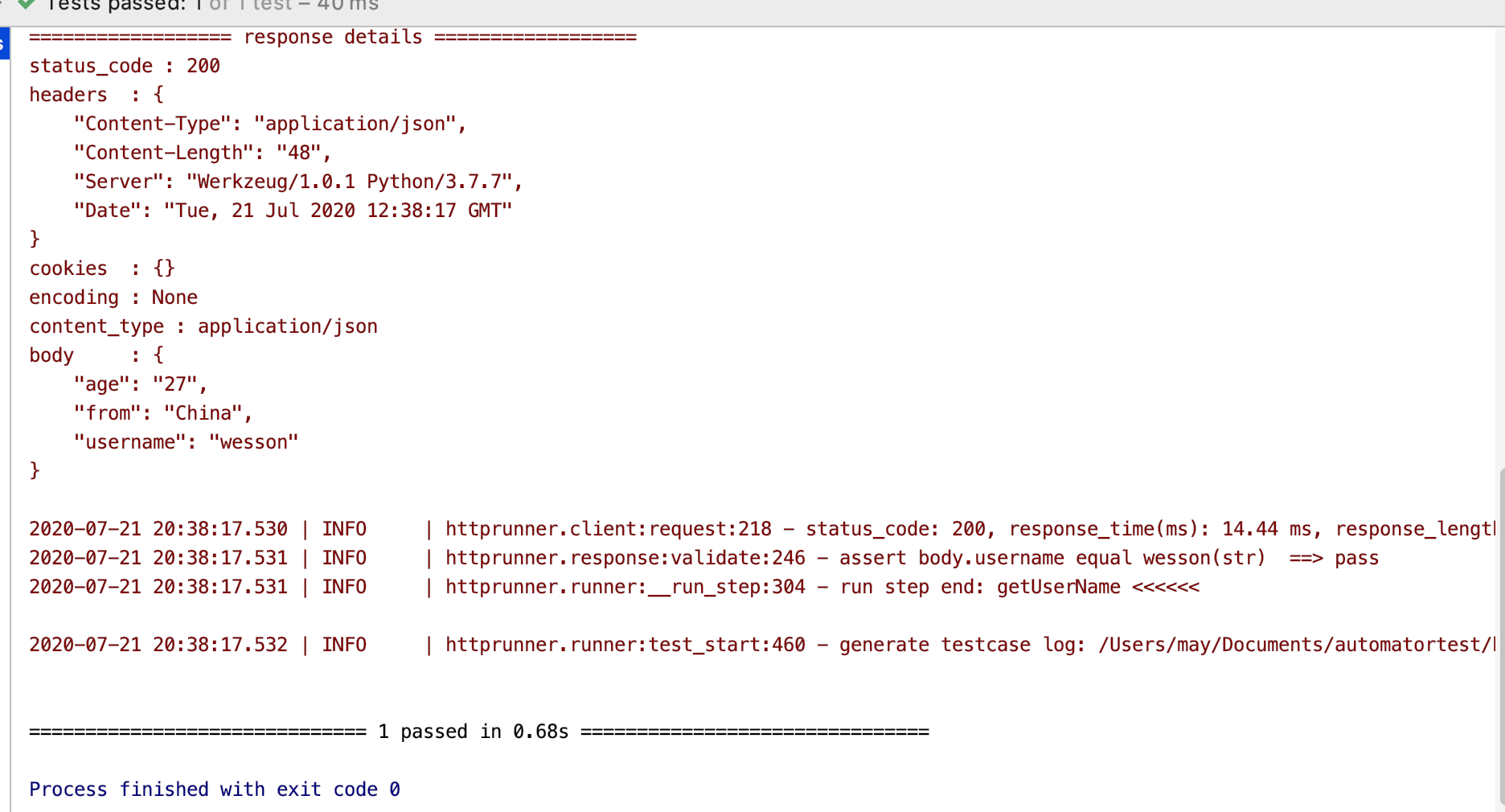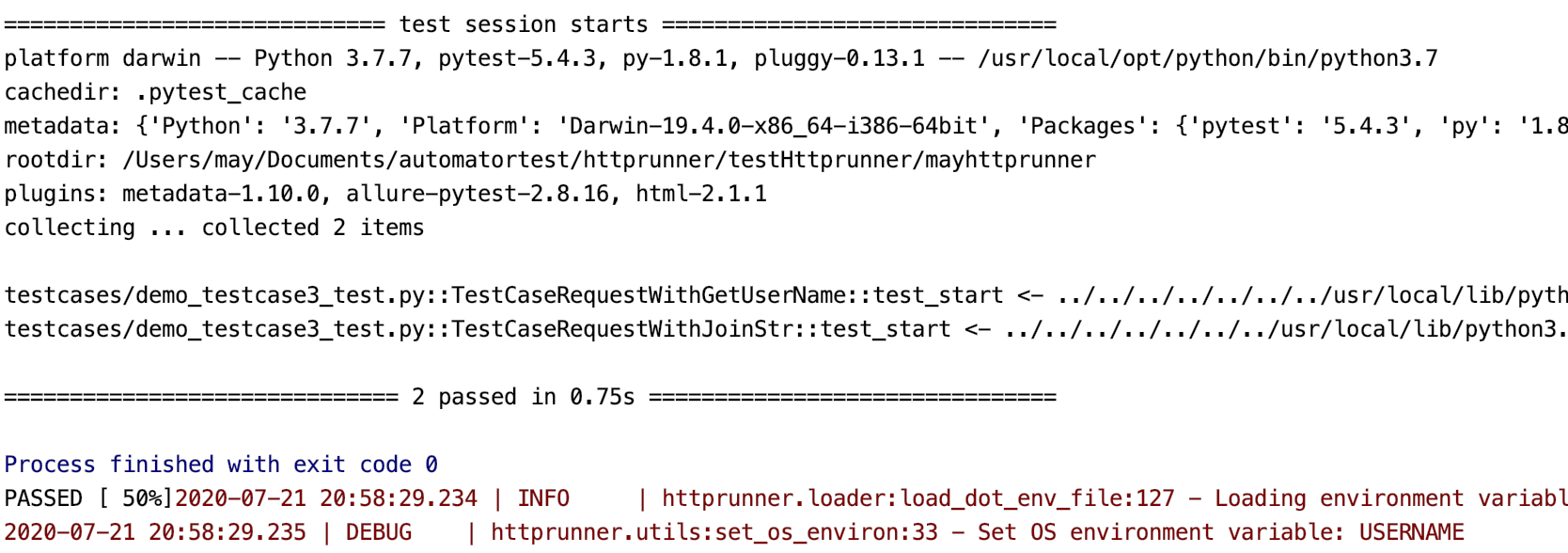用flask快速写了2个接口,以供在本地调用:
from flask import Flask from flask import request app = Flask(__name__) @app.route('/') def hello_world(): return 'Hello World!'
@app.route('/getUserName', methods=['GET']) def get_user_name(): if request.method == 'GET': return { "username": "wesson", "age": "27", "from": "China", }
@app.route('/joinStr', methods=['GET']) def str_join(): if request.method == 'GET': str1 = request.args.get("str1") str2 = request.args.get("str2") after_join = str1 + " " + str2 return { "result": after_join }
if __name__ == '__main__': app.run()
一共有2个接口:
- /getUserName,查询用户名,返回是写死的字典。
- /joinStr,两个字符串拼接,返回的是拼接后的结果。
运行后可在浏览器查看:


一、编写测试用例
因为这个接口没有传参,cookie之类的,就省掉了,只是demo用。
1. 接口:/getUserName
from httprunner import HttpRunner, Config, Step, RunRequest, RunTestCase class TestCaseRequestWithGetUserName(HttpRunner): config = ( Config("test /getUserName") .base_url("http://localhost:5000") .verify(False) ) teststeps = [ Step( RunRequest("getUserName") .get("/getUserName") .validate() .assert_equal("body.username", "wesson") ), ] if __name__ == "__main__": TestCaseRequestWithGetUserName().test_start()
断言是验证返回的username字段值是不是“wesson”,运行一下,可以看到测试通过

若报错:pytest运行报错nknown hook 'pytest_namespace' in plugin <module 'allure.pytest_plugin'
若报错:httprunner 3运行报错AttributeError: module 'allure' has no attribute 'severity_level'
2. 接口:/joinStr
这个接口就需要2个传参了,那么在Step里通过.with_params()来传参。
from httprunner import HttpRunner, Config, Step, RunRequest class TestCaseRequestWithJoinStr(HttpRunner): config = ( Config("test /joinStr") .base_url("http://localhost:5000") .verify(False) ) teststeps = [ Step( RunRequest("joinStr") .get("/joinStr") .with_params(**{"str1": "hello", "str2": "may"}) .validate() .assert_equal("body.result", "hello may") ), ] if __name__ == "__main__": TestCaseRequestWithJoinStr().test_start()
传入的参数分别是“hello”、“may”,接口写的这个字符串在拼接的时候是加了一个空格的,所以断言的时候预期的值是"hello may"。
运行测试,可以看的测试通过。

二、testcase引用&变量传递
以上是2个分开的case,都可以分别正常运行。
假设,/joinStr接口的第二个参数,是依赖/getUserName接口的返回,那么现在这2个testcase之间就有了依赖关系。
那么在写/getUserName接口用例的时候,就需要去引用/joinStr的测试用例了,并且需要把/getUserName用例的变量导出来,/joinStr的测试用例传参时候使用。
1. 首先,先修改/getUserName接口的case:
from httprunner import HttpRunner, Config, Step, RunRequest class TestCaseRequestWithGetUserName(HttpRunner): config = ( Config("test /getUserName") .base_url("http://localhost:5000") .verify(False) .export(*["username"]) # 这里定义出要导出的变量 ) teststeps = [ Step( RunRequest("getUserName") .get("/getUserName") .extract() .with_jmespath("body.username", "username") # 提取出目标值,赋值给username变量 .validate() .assert_equal("body.username", "wesson") ), ] if __name__ == "__main__": TestCaseRequestWithGetUserName().test_start()
注释部分的代码,一个是config里定义了这个要导出的变量,另一个是在Step中,讲目标值提取出来,赋值给变量username
2. 接下来,修改/joinStr接口的测试用例:调用上一个接口
from httprunner import HttpRunner, Config, Step, RunRequest, RunTestCase from .demo_testcase2_test import TestCaseRequestWithGetUserName # 导入要引用的类 class TestCaseRequestWithJoinStr(HttpRunner): config = ( Config("test /joinStr") .base_url("http://localhost:5000") .verify(False) ) teststeps = [ Step( RunTestCase("setUp getUserName") .call(TestCaseRequestWithGetUserName) # 导入后就可以调用了 .export(*["username"]) # 在RunTestCase步骤中定义这个变量的导出 ), Step( RunRequest("joinStr") .get("/joinStr") .with_params(**{"str1": "hello", "str2": "$username"}) # 在第二个传参中引用导出的变量 .validate() .assert_equal("body.result", "hello $username") # 断言的预期值也引用变量 ), ] if __name__ == "__main__": TestCaseRequestWithJoinStr().test_start()
运行/joinStr接口的测试用例,可以看到运行通过

来源 https://www.cnblogs.com/pingguo-softwaretesting/p/13215627.html